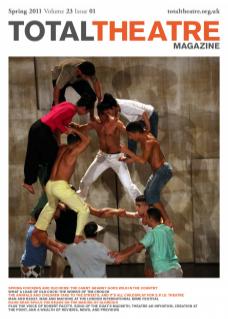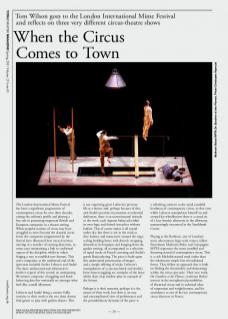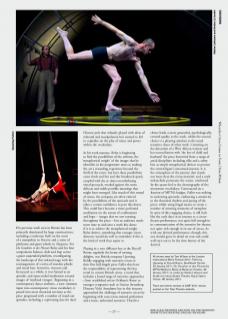The London International Mime Festival has been a significant programmer of contemporary circus for over three decades, raising the artform’s profile and playing a key role in presenting important British and European companies in a theatre setting. Where popular notions of circus may have struggled to move beyond the classical circus form, the companies programmed by the festival have illustrated how circus has been moving in a number of exciting directions, in some cases maintaining a link to traditional aspects of the discipline whilst in others forging a way to establish new formats. This year’s companies at the traditional end of the spectrum included Atelier Lefeuvre and André. The duo’s understated and whimsical Le Jardin is typical of this strand: an unimposing 90-minute composite of juggling and handbalancing sketches notionally set amongst what feels like a small allotment.
Lefeuvre and André bring a certain Gallic rusticity to their work as the two dour clowns find games to play with garden objects. This is not surprising given Lefeuvre’s previous life as a farmer and, perhaps because of this, and André’s previous incarnation as industrial draftsman, there is an unsentimental attitude to the work, each vignette balanced within its own logic and slotted into place without fanfare. This of course makes it all sound rather dry, but there is wit in the work as they balance and manoeuvre around the stage, scaling bedding boxes with shovels, wrapping themselves in hosepipes and hanging from the garden awning, all accompanied to a selection of taped tracks of French crooning and André’s gentle Banjo playing. The piece is built upon this understated presentation of images and a simple offering of tricks: Lefeuvre’s manipulation of a concrete block and André’s brow-beaten juggling are examples of the latter, whilst their crisp shadow-play an example of the former.
Perhaps it is their maturity, perhaps it is the nature of their work, but there is an easy and uncomplicated view of performance and the perambulatory dynamic of the piece is a refreshing contrast to the usual youthful brashness of contemporary circus, so that even whilst Lefeuvre manipulates himself on and around his wheelbarrow there is a casual air of a lazy Sunday afternoon in the allotment, unassumingly ensconced in the Southbank Centre.
Playing at the Barbican, one of London’s more adventurous large-scale venues, fellow Frenchman Mathurin Bolze and Compagnie MPTA represents the more youthful and thrusting strand of contemporary circus. This is a rich Michelin-starred meal rather than the wholesome simple fare of traditional forms. They follow an approach that is built on finding the theatricality and dramaturgy within the circus spectacle. Their new work, Du Goudron et des Plumes, continues Bolze’s interest in the metaphorical possibilities of theatrical circus and in technical ideas of suspension and weightlessness, and his ascendancy as one of the key contemporary circus directors in France.
His previous work seen in Britain has been primarily dominated by large constructions, including a treehouse built on the roots of a trampoline in Fenetres and a series of platforms and giant wheels in Tangentes. For Du Goudron et des Plumes Bolze and his four companions balance, slide and leap across a giant suspended platform, reconfiguring the landscape of this isolated stage with the rearrangement of a series of wooden planks and metal bars. Inventive, virtuoso and fast-paced as a whole, it was framed as an episodic and open-ended meditation around images of ‘mythical voyages’. Beginning in a contemporary dance aesthetic, a now common input into contemporary circus vocabulary, it passed into more theatrical territory as the piece progressed with a number of stand-out episodes, including a captivating duo for dual Chinese pole that robustly played with ideas of rebound and manipulation but seemed to fail to capitalise on the play of status and power within the vocabulary.
As his work matures, Bolze is beginning to find the possibilities of the artform, the ‘metaphorical weight’ of the images that he identifies in the programme notes as making the art a rewarding experience beyond the thrill of the event, but here these possibilities come thick and fast and this breakneck speed, coupled with the at times overwhelming visual spectacle, worked against the more delicate and subtle possible meanings that might have emerged. Like much of this strand of circus, the company are often enticed by the possibilities of the spectacle and it takes a certain confidence to pare this down. This could have become a more profound meditation on the nature of confinement and hope – images that we saw running throughout the piece – but an audience needs more time to sink into a work this dense if it is to achieve the metaphorical weight Bolze desires, something that younger circus directors would do well to remember if this is the kind of work they aspire to.
Playing in a very different key at the Purcell Room, regularly the home of unsung delights, was British company Upswing. Boldly engaging with narrative circus in their first full-length piece Fallen they have the responsibility of representing this key trend in current British circus, a trend that includes a board range of narrative approaches – from established artists Ockham’s Razor to younger companies such as Genius Sweatshop. Director Vicki Amedume has in this instance approached the challenge of narrative circus by beginning with non-circus-trained performers and a loose, unhurried narrative. This first choice lends a more grounded, psychologically-centred quality to the work, whilst the second choice is a pleasing antidote to the usual narrative chaos of other work. Centering on the detention of a West African woman and her reconciliation with ‘the loss of child and husband’ the piece borrowed from a range of aerial disciplines including silks and a safety line as simple metaphorical devices to present the central figure’s emotional journey. It is the atmosphere of the journey that stands out more than the circus material, and a stark melancholy permeates the scenes, reinforced by the sparse feel to the choreography of the movement vocabulary. Constructed on a fraction of MPTA’s budget, Fallen was striking in eschewing spectacle, embracing a sensitivity to the theatrical rhythm and pacing of the piece, whilst using frugal means to create a number of arresting moments of metaphor. In spite of this engaging choice, it still feels like the early days in its journey as a circus-theatre performance, not quite full enough in its communication of the narrative for theatre, nor quite rich enough in its use of circus. As with any devised performance, though, this one should grow in detail on tour and could well turn out to be the slow burner of the festival.
All shows seen by Tom Wilson at the London International Mime Festival 2011: Fallen by Upswing at Purcell Room, Southbank Centre, 25 January 2011; Du Goudron et des Plumes by MPTA/Mathurin Bolze at Barbican Theatre, 26 January 2011; Le Jardin by Atelier Lefeuvre and André at Linbury Studio Theatre, Royal Opera House, 28 January 2011.
There are further reviews of LIMF 2011 shows posted on the Total Theatre website.


